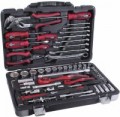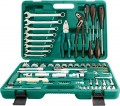Total number of items
The total number of core items included in the set.
In this case, the main items are all devices that are directly used during work: non-separable tools (traditional wrenches, hammers, pliers ...), elements of collapsible tools (for example, a ratchet for removable heads and 5 such heads will be considered 6 units) , as well as accessories (such as extensions or universal joints). Additional accessories — such as lights — may or may not be included in this count, depending on the manufacturer; however, there are usually few such accessories, and they do not fundamentally affect the total number of items.
The most modest modern tool kits include
up to 25 units. However, such kits are very popular — they are inexpensive and at the same time can be very versatile.
25 – 50 items is still quite a small number,
50 – 75 pcs can be called an average,
76 – 100 items are more than average, and the most extensive modern sets can include
100 – 150 items or even
more.
The general rules for choosing this parameter are obvious: a more extensive set, usually, is more multifunctional, but more expensive, weighs more and takes up more space. It is also worth bearing in mind that with a similar number of items, the specific assortment of these items in differ
...ent sets may be different; so when choosing, it is worth specifying not only the number of tools, but also their specific composition.Square drive size
The size of the "seat" for which the socket heads included in the package are designed (see below), in other words, the size of the square hole on the back of the head used for installation on a ratchet, wrench or other similar tool. Accordingly, the tool for working with heads supplied in the kit has the same dimensions of the landing square; and in the absence of such tools in the kit, data on the size of the heads will be useful for its selection.
There is a generally accepted standard for these sizes, providing for the designation in fractions of an inch — from 1/4 "to 1". Thanks to this, heads and tools from different sets can be quite compatible — just matching in size is enough. Most often in modern hand sets there are options in 1/4 "and 1/2", a little less often — 3/4" and 3/8". Some sets include several variants of the landing square at once.
Hex wrenches size
Working size range of hex wrench sizes (see above) supplied with the kit. This parameter allows you to evaluate how the keys fit the dimensions of the fasteners with which they are planned to be used.
Slotted
Screwdrivers with flat tips, originally designed for a slot in the form of a slot. Note that such tips are quite versatile, they can be used with cross slots, and even with asterisks — the only thing is that in such cases it is impossible to apply great efforts due to the high probability of tool breakage.
Cross-recess
Screwdrivers with tips designed for cross slots. Note that flat screwdrivers also work with such slots; however, it is still better to use “native” tools — they distribute the load more evenly and allow you to apply great efforts without the risk of tearing the edges of the slot.
Weight
The total weight of the tool kit. Indicated with a case, stand or other storage/transportation device (see Tool Storage). First of all, you should pay attention to this parameter if you plan to often carry the kit over long distances — the lighter the weight, the easier it will be to do. At the same time, extensive sets inevitably turn out to be weighty.

